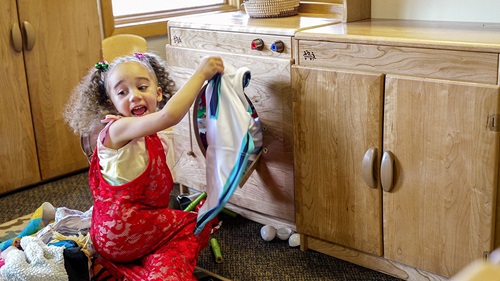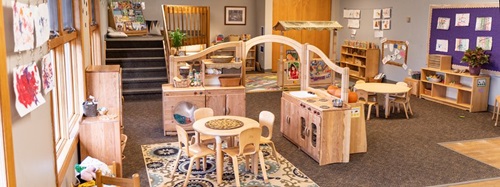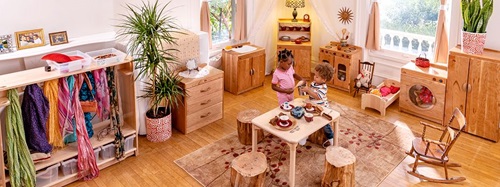Creating Supportive Environments for Children's Sensory Experiences
| June 2025Young children experience the world primarily through their senses—sight, sound, touch, taste, and smell. Their perception is immediate and direct, creating a rich tapestry of experiences. Yet each child’s perceptual experience, or sensory bubble, is unique. A well- designed early childhood classroom takes these varying sensory bubbles into account in order to meet the developing needs of every child.
One way to understand these sensory bubbles is to look at the world of animals. Baltic-German zoologist Jakob von Ueskull theorized that even though two organisms share the same environment, they experience it differently. He coined the unique way a specific animal experiences the world around it as its Umwelt Bubble (“umwelt” meaning “environment” in German). He believed that each creature lives cocooned in its own perceptual bubble.
For example, the catfish lives in an umwelt bubble of taste because its body is covered with tongues. The catfish is literally a swimming tongue and can taste dinner before the food enters its mouth. The great gray owl, on the other hand, lives in the umwelt bubble of hearing and can pluck a mouse from its snow-covered hideaway solely by listening to the scurrying or chewing sounds coming from beneath twelve inches of snow.
Each of these creatures has a unique experience of their environment, and the same could be said for each child. For young children, their umwelt bubbles are shaped by their sensory experiences.
Sensory Bubbles and Young Children
Children develop their sensory abilities through daily experiences, each in their own unique way. While all children face challenges with sensory regulation and behavior management at times, some struggle more than others. For those with more sensitive sensory systems, certain stimuli may feel overwhelming, whereas others may hardly react to the same sensations.
Some children have a hard time processing sensory stimulus, causing their systems to overload. They may flinch at sudden noises, become upset with certain textures, or avoid bright lights. These children often experience anxiety and stress in an overstimulating environment, which may lead to meltdowns and withdrawal from social interactions. At times these children struggle with peer relationships, finding it difficult to maintain friendships, resulting in feelings of isolation or frustration and may even affect their learning.
Other children experiencing hyposensitivity have a reduced response to sensory input. They may not notice sounds, touch, or visual stimuli that others find obvious. These children compensate by seeking out intensive sensory experiences. Hyposensitive children may engage in behaviors such as spinning, jumping, or touching various textures to achieve sufficient sensory stimulation. These behaviors can impact a child’s ability to focus and engage in structured activities. Additionally, hyposensitive children may not react strongly to pain, which leads to risk-taking behaviors.
Supporting Environments for Children’s Sensory Needs
Understanding how children experience the environment enables educators to create supportive environments catering to children’s individual sensory processing needs. Here are some strategies for designing supportive environments for all children.
Provide Recalibration Spaces.
Children struggling to process experiences or activities may benefit from a quiet space where they can withdraw from sensory stimuli and social interactions. These spaces should be on the perimeter of the classroom away from the center of action and accommodate one child. A recalibration space like this should have decreased visual and auditory stimuli, and include a calming tool kit (e.g., pillows, weighted objects, tactile items, headphones). Consider using the smaller enclosed spaces behind a shelf or under a counter (keep in mind adult sightlines for supervision).
Conversely, a sensory room (or space) can be helpful for a child experiencing hyposensitivity. These environments provide a variety of sensory experiences aimed at stimulating and engaging their senses. These sensory rooms include tactile materials (different textures), visual stimuli (light and shadow play), and proprioceptive activities (climbing or jumping). The key to a recalibration space is that children have control over the space so they can recalibrate when needed out of the general rush of the classroom.
Use Flexible Lighting.
Incorporating light gradience in environments for young children offers numerous benefits, including enhanced comfort, improved focus, and support for emotional well-being. The use of natural lighting can positively influence children’s mood and reduce anxiety. The constant flicker from overhead florescent lighting can often cause distress. A resolution for this is to layer the lighting in your classroom using supplemental lighting such as floor, hanging, or table lamps as well as experiences with light tables and unbreakable mirrors.
Use Varied Textures and Materials.
Making varied sensory stimuli available gives children the chance to play at their own sensory comfort level and take appropriate sensory risks at their own pace.
Providing varied textures and materials in sensory bins (e.g., sand, water, natural materials) will engage children while allowing them to explore at their sensory comfort level. Offering mats with different surfaces (e.g., soft, rough, bumpy) for children to walk on or touch promotes exploration.
Flexible manipulatives are great additions to the early childhood environment. Offer a variety of fidget toys with different textures, such as squishy balls, textured strips, or sensory rings.
Soft furnishings like bean bags, cushions, and plush rugs help create cozy spaces where children can self-regulate. For hypersensitive children, weighted blankets can provide comfort and a sense of security especially when combined with recalibration spaces.
Consider Sound Control.
Sound control is critical in early childhood environments, especially for accommodating the needs of children with sensory processing challenges. Sound-absorbing materials such as carpets, area rugs, and acoustic panels can help minimize noise levels. Installing acoustic tiles or panels on ceilings further contributes to reducing overall classroom noise. Additionally, soft furnishings aid in sound absorption, creating a quieter environment for children.
Incorporate regular quiet times throughout the day to provide periods of low stimulation, allowing hypersensitive children to recharge. Consider incorporating flexible activity planning into the daily schedule. Adapt group activities to include both quiet and active components, catering to different sensory needs. For example, balance quiet story time with interactive, louder play. For the hypersensitive children who may need additional support in noisy environments, provide noise-canceling headphones. Educate children on self-regulation strategies, such as taking deep breaths or using quiet signals when they feel overwhelmed by noise.
Designing a Balanced Sensory Environment
Designing a balanced environment that supports the sensory needs of all children is essential for effective early childhood settings. Providing flexible choices allows children to explore at their own pace while giving teachers the ability to adjust materials as needed. For children with heightened sensitivity, gradually introducing sensory experiences in a controlled manner can help build tolerance. Conversely, structured sensory play can assist hyposensitive children in safely navigating their surroundings. While achieving this balance in the classroom may be challenging, here are some strategies to help create an inclusive and supportive learning environment.
- Provide quiet spaces with soft lighting, minimal noise, and calming colors.
- Provide active spaces with dynamic lighting, engaging textures, and interactive elements.
- Incorporate sensory walls, vertical learning spaces, or interactive panels that provide stimulation without overwhelming hypersensitive children.
- Utilize adjustable lighting that can be dimmed or brightened.
- Incorporate windows and skylights for natural lighting and a view of nature.
- Create sensory bins with different textures and items that can be used for both gentle exploration and more active play.
- Allow children to choose materials and textures they feel comfortable with. Create personalized sensory kits for children based on their preferences.
- Use sound-absorbing materials to reduce noise levels in active areas.
- Consider incorporating soft background music or nature sounds that can provide a calming effect for hypersensitive children while engaging hyposensitive children
- Provide training to educators on the impact of sound and other sensory input on children’s behavior.
- Collaborate with families to understand children’s sensory preferences.
By creating spaces that cater to children’s different sensory needs, educators can promote inclusive, supportive environments that enhance learning, development, and well-being for all children’s umwelt bubbles. Just as the catfish and owl thrive in their umwelt bubbles of tasting and hearing, so can children thrive in carefully curated learning environments, which are aligned with their sensory needs.
Resources
Ayres, A.J. (1979). Sensory Integration and the Child. Los Angeles: Western Psychological Services. Dunn, W. (1997). The impact of sensory processing abilities on the daily lives of young children and families: A conceptual model. Infants and Young Children, 9(4), 23-25.Dunn, W. (1999). The Sensory Profile: User’s Manual. San Antonio, TX: Psychological Corporation. du Preez, H. & Combrinck, C.M. (2022). The Sensory Classroom Teacher Questionnaire: A tool for assessing conducive classroom conditions for children with ADHA. African Journal of Psychological Assessment, 4(436), https://doi.org/10.4102/ajopa.v4i0.107.
Fisher, K.R. et al. (2014). The role of quiet spaces in early childhood education. Early Childhood Research Quarterly, 29(1), 45-54.
Isbell, C. & Isbell, R. (2007). Sensory Integration: A Practical Guide for Preschool Teachers. Beltsville, MD: Gryphon House.
Knez, I. (1995). Effects of indoor lighting on mood and cognition. Journal of Environmental Psychology, 15(1), 223-238.
Kranowitz, C.S. (1998). The Out-of-Sync Child: Recognizing and Coping with Sensory Integration Dysfunction. New York: Skylight Press.
Noddings, A. (2017). Classroom Solutions for Sensory-Sensitive Students. Montessori Life: A Publication of the American Montessori Society, 29(2), 44-49.
Pfeiffer, B., Kinnealey, M., & Henderson, L. (2011). The Effectiveness of Sensory Integration Interventions in Children with Autism Spectrum Disorders: A Systematic Review. American Journal of Occupational Therapy, 65(2), 207-215,
Williamson, G. & Anzalone, M.E. (2001). Sensory Integration and Self-Regulation in Infants and Toddlers: Helping Very Young Children Interact with Their Environment. Washington, DC: Zero to 3.
Zane, L. (2015). Pedagogy and Space: Design Inspirations for Early Childhood Classrooms. St. Paul, MN: Redleaf Press.














